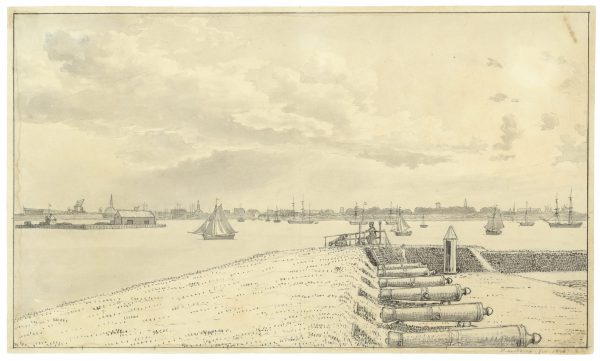View from the Battery of Trekroner with Copenhagen in the Distance, 1836
Pen and black ink, pencil and grey wash on paper, H. 185 mm; W. 315 mm
Signed and dated lower right: Eckersberg fec. 1836 and inscribed on the back: Eckersberg 7 Sept. 1836.
Provenance: The artist’s estate sale, Copenhagen, January 1854, lot 375; there described “a view from Trekroner. Indian ink; very elaborate”, Copenhagen.
Private Collection, Denmark.
C. W. Eckersbergs dagbøger 1810-1837, vol. 1, Copenhagen, 2009, p. 703.
Justly considered the “Father of Danish painting”, Eckersberg taught at the Royal Academy in Copenhagen for 35 years and brought about monumental developments in Danish art. He was active in many genres: history painting, portraiture (he completed over 150 portraits), landscape, notably architectural painting and seascapes.
From 1803 to 1810 he studied at the Academy, then led by N.A. Abildgaard, where he aspired to a career in history painting. After winning a gold medal, he left for Paris in 1810. He studied under Jacques-Louis David for one year, a period that proved decisive in his artistic development.
During his stay in Rome from 1813 to 1816, he reached his artistic maturity, working on plein air pieces and completing a series of perspectives of the city from unusual points of view. Upon his return to Copenhagen, he became a professor at the Academy in 1818.
Eckersberg founded his art on the observation of nature and on the principles of classical composition. Drawing after life, using both male and female models, was an integral part of his teaching. He also often brought his students to the areas surrounding Copenhagen to make them paint outdoors. Linear perspective became an essential component of his instruction. In his two treatises on the subject, published in 1833 and 1841, he defined the rules of the construction of space as well as the rendering of shadow.
In spite of the many commissions for history paintings and portraits he received, Eckersberg was able to dedicate more and more time to seascape painting, a genre about which he was passionate from the 1820s until the end of his days.
Eckersberg wrote in his diary on 7 September 1836: “Went to the battery at 9 o’clock to see the Russian ships, but the wind was not good for sailing. Went ashore with Normann and his wife at 11 o’clock and on board again with them at 1 o’clock, it became calm. – Drew a view from the battery towards the city”. Most probably the present drawing had been executed on that day. It relates to a small but very prominent painting also from 1836 depicting a View from the Battery of Trekroner with Copenhagen in the Distance [fig. 1]. Trekroner is a fortification on a small island at the entrance of Copenhagen. When Eckersberg did the painting he was standing in a different place on Trekroner than when he did the present drawing. Consequently the foreground is different, but the view of Copenhagen is almost identical.


